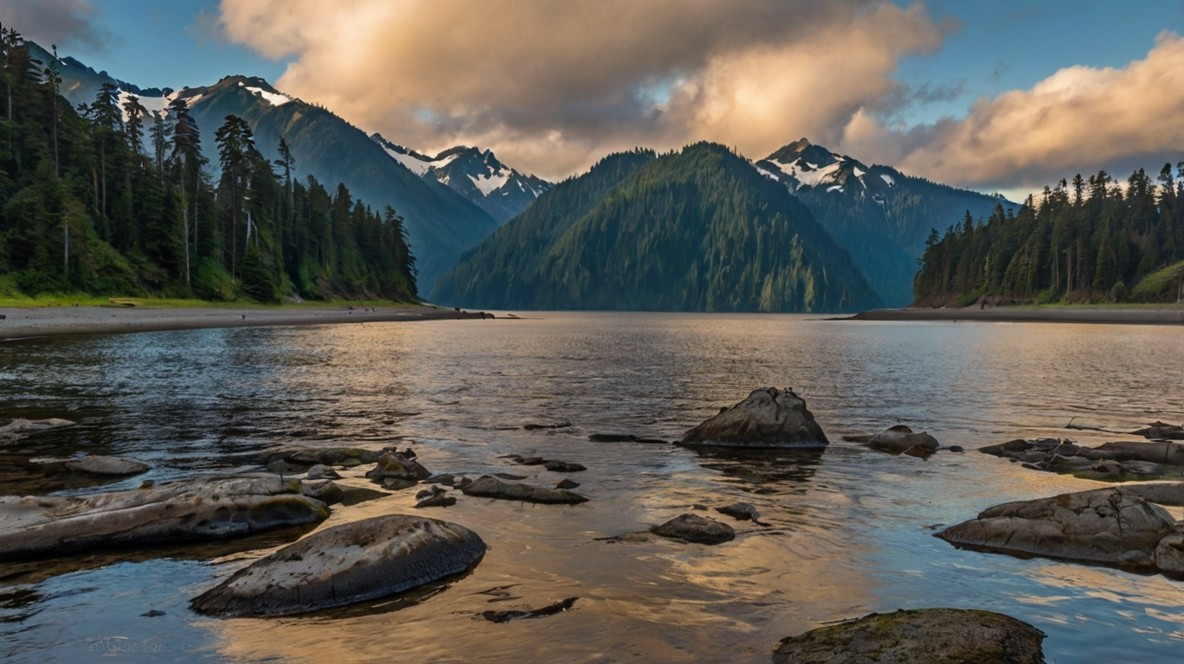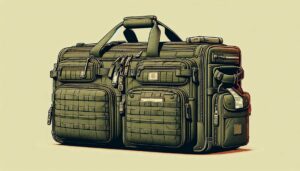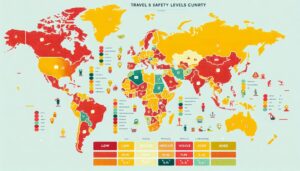Who says you need to go abroad for an awesome vacation? You don’t have to go far, folks! Today, we’re going to explore one of the hidden paradises in the United States: Olympic National Park. This place isn’t just your average park; it’s a haven for adventurers and nature lovers. So, get ready as we uncover all the secrets to make your trip to Olympic National Park an unforgettable experience!
I. Introduction
A. About Olympic National Park
Olympic National Park is like a piece of heaven that got lost on Earth, folks! Just imagine, it spans nearly 1 million acres (about 4,000 square kilometers) combining lush rainforests, towering mountains, and untamed wild beaches. Located on the Olympic Peninsula in Washington State, it’s home to diverse ecosystems that’ll make your jaw drop!
B. Unique features and main attractions
So, what makes Olympic National Park different from other national parks? First off, this place has three distinct ecosystems in one area: you’ve got mountains with year-round snow caps, temperate rainforests that are super moist, and a wild Pacific coastline. Secondly, you can find endemic species here that you won’t see anywhere else, like the Roosevelt Elk that’s become the park’s icon.
And don’t even get me started on the views – they’ll keep your mouth hanging open. From the snow-capped peaks of the Olympic Mountains to beaches with giant rock formations that look like nature’s artwork. Seriously, if you’re into challenges and epic natural scenery, Olympic National Park needs to be on your bucket list!
II. Pre-Trip Preparation
A. Best time to visit Olympic National Park
Want to know the best time to hit up Olympic National Park? Truth is, the park’s open year-round. But if you want the cream of the crop, come during summer, from July to September. Why? Because the weather’s at its best, not too cold, and the days are long. So you’ve got more time to explore!
But don’t worry if you can’t make it in summer. Each season has its own charm. Spring? Wild flowers in bloom, waterfalls at their mightiest. Fall? Leaves changing colors, making the scenery even more spectacular. Winter? Perfect for skiing or snowshoeing. Bottom line, whenever you come, there’ll be something awesome!
B. Transportation to the national park
Now, how do you get there? Easy, folks! If you’re coming from abroad or another US city, fly into Seattle-Tacoma International Airport first. From there, you’ve got a few options:
- Rent a car: This is the most flexible option. From Seattle, it’s about a 2-3 hour drive to Olympic National Park, depending on your specific destination.
- Shuttle bus: There are a few companies that provide shuttle services from Seattle to various points on the Olympic Peninsula.
- Ferry: For a more adventurous experience, try taking a ferry from Seattle to Bainbridge Island or Bremerton, then continue by car.
- Public transport: You can also use a combination of buses and ferries, but this option is a bit more complicated and time-consuming.
Pro tip: If you can, just rent a car. Public transportation within the park is limited. Having your own car will give you more freedom to explore all the cool spots in Olympic National Park.
C. Essential gear to pack
Okay, now let’s talk gear. Remember, Olympic National Park is real wilderness, not a city park. So your prep needs to be on point! Here’s a list of must-bring gear:
- Comfortable, waterproof hiking boots. Trust me, these will be your best friends while you’re there.
- Waterproof and windproof jacket. The weather here can be unpredictable, so be prepared.
- Layered clothing. Mornings can be cold, midday hot, evenings cold again. So bring clothes you can layer.
- Hat and sunglasses. The sun can be pretty intense in the mountains and on the beach.
- Sunscreen and insect repellent. Don’t let sunburn or mosquito bites ruin your vacation.
- Refillable water bottle. Staying hydrated is super important!
- Snacks and light meals. To boost your energy while you’re out and about.
- First aid kit. Hopefully you won’t need it, but better safe than sorry, right?
- Map and compass. Don’t rely too much on GPS; the signal isn’t always great out there.
- Power bank. Just in case your phone runs out of juice while you’re taking all those awesome photos.
Alright, all set? Let’s start the adventure!
III. Day One: Exploring the Coast
A. Hurricane Ridge
We’ll start our first day with a visit to Hurricane Ridge. This place is kind of like the “balcony” of Olympic National Park. Why? Because from here, you’ll get a 360-degree view that’ll blow your mind!
1. Spectacular views
Once you get to the top, I guarantee you’ll be gaping. Right in front of you, there’s a range of Olympic Mountains with their snow-capped peaks. On a clear day, you can even see all the way to the Strait of Juan de Fuca and British Columbia in Canada. I’m telling you, the view is straight out of a fantasy film!
Pro tip: Come early to catch the sunrise. The sight of the sun rising behind the mountains is out of this world!
2. Activities you can do
Now, Hurricane Ridge isn’t just for taking photos. There are plenty of cool activities you can do:
- Hiking: There are several hiking trails with different difficulty levels. For beginners, try the Hurricane Hill Trail. It’s only 3 miles round trip, but the view is top-notch.
- Wildlife watching: Get your camera ready! Here you might spot blacktail deer, marmots, and sometimes even black bears (but don’t get too close!).
- Skiing and snowboarding: If you come in winter, Hurricane Ridge becomes a paradise for skiers and snowboarders.
- Stargazing: At night, the sky is super clear, free from light pollution. Perfect for stargazing or hunting for auroras.
B. Ruby Beach
After you’ve had your fill of Hurricane Ridge, we’ll head to Ruby Beach. If we were up in the mountains earlier, now we’ll enjoy the charm of the famous Pacific Northwest coast.
1. Beauty of the sea stacks
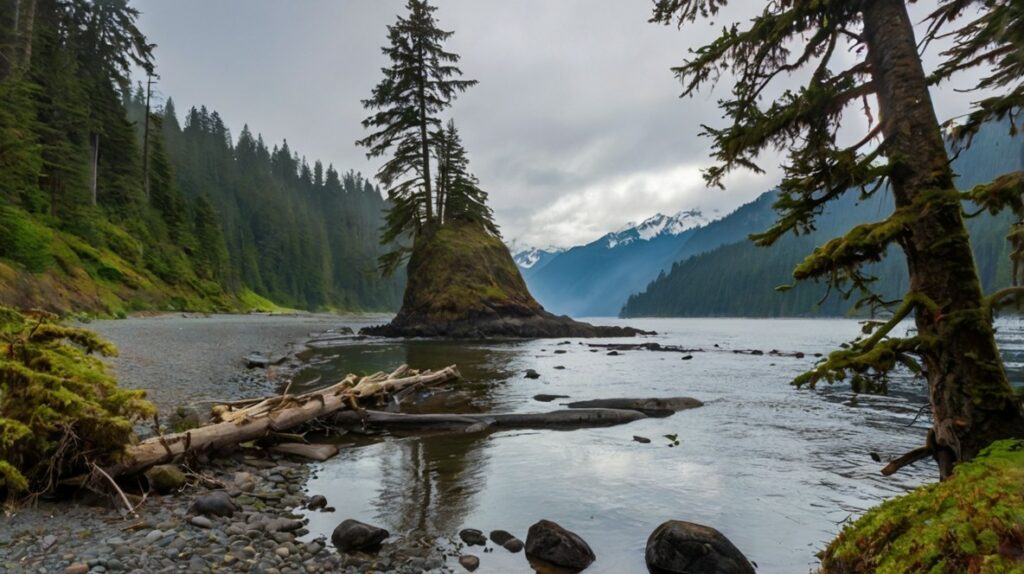
Ruby Beach isn’t your average beach. Here, you’ll see scenery that’s like something out of a movie: giant sea stacks standing tall at the edge of the beach, surrounded by a thin mist that makes the atmosphere even more mystical.
The most famous sea stack is called “Destruction Island Lighthouse”. When the tide is low, you can walk among these rock formations. But remember, watch out for the incoming tide!
2. Enjoying the sunset on the beach
Nothing beats the beauty of a sunset at Ruby Beach. Just imagine, the sun slowly sinking into the Pacific Ocean, creating a gradient of orange, pink, and purple in the sky. Meanwhile, the silhouettes of the sea stacks standing tall make the scene even more dramatic.
Pro tip: Bring some snacks and a blanket, and have a little picnic while waiting for the sunset. I guarantee it’ll be a moment you won’t forget!
Don’t forget, before it gets dark, we head back to our accommodation. Get plenty of rest, because tomorrow we’ll be exploring the rainforest!
IV. Day Two: Rainforest Adventure
A. Hoh Rain Forest
Get ready to enter a world that’s like something out of the movie Avatar! Today we’ll be exploring Hoh Rain Forest, one of the largest temperate rainforests in North America. This place is truly magical, folks!
1. Hall of Mosses Trail
Now, the most popular trail in Hoh Rain Forest is called the Hall of Mosses. It’s only about 0.8 miles, but I guarantee it’ll leave you in awe. Why? Because all along the way, you’ll be surrounded by giant trees covered in thick moss. I’m telling you, it feels like you’ve stepped into a fairy world!
Along the trail, you’ll find:
- Maple trees covered in moss, looking like aliens
- Sitka spruce trees that can reach up to 300 feet tall
- Various types of ferns and vines that add to the mystical atmosphere
Pro tip: Don’t forget to bring a rain jacket or poncho. It’s called a rainforest for a reason, so be prepared to get a little wet!
2. Observing unique flora and fauna
Hoh Rain Forest isn’t just about trees and moss. Here, you can find a variety of unique flora and fauna that you might never have seen before:
- Roosevelt Elk: The giant deer that’s become the icon of Olympic National Park
- Banana slug: Giant yellow slugs that can grow up to 10 inches long!
- Rare birds: Like the Northern Spotted Owl or Marbled Murrelet
- Unique mushrooms: Some look like fans, others are super colorful
Remember, we can only look and take photos. Don’t disturb or take anything from their habitat!
B. Sol Duc Valley
After we’ve had our fill of Hoh Rain Forest, we’ll continue to Sol Duc Valley. This place is famous for its waterfalls and hot springs.
1. Sol Duc Falls
Sol Duc Falls is truly beautiful, folks! It’s about 50 feet high and splits into three streams that fall into the pool below. The scenery is like something straight out of a postcard!
To get to the waterfall, you have to walk about 0.8 miles from the parking lot. The path isn’t too difficult, in fact it’s quite enjoyable. Along the way, you’ll be surrounded by tall trees and the sound of trickling water that’s super refreshing.
Pro tip: Try coming early in the morning or towards the evening. Besides being less crowded, the sunlight filtering through the leaves will make the scenery even more dramatic!
2. Soaking in Sol Duc Hot Springs
Now, after you’re tired from all the walking, it’s time to relax at Sol Duc Hot Springs Resort. This is absolute heaven for those who love soaking in natural hot springs.
Here, there are several pools with different temperatures:
- Hottest pool: temperature around 40°C (104°F)
- Medium pool: temperature around 35°C (95°F)
- Cold pool: temperature around 10°C (50°F) (for the brave ones!)
While soaking, you can enjoy the view of the surrounding forest. I’m telling you, it feels like being in a fancy spa, but the natural version!
Remember, before soaking:
- Take a shower first to clean up
- Don’t soak for more than 15 minutes at a time
- Drink plenty of water to stay hydrated
V. Day Three: Mountain Exploration
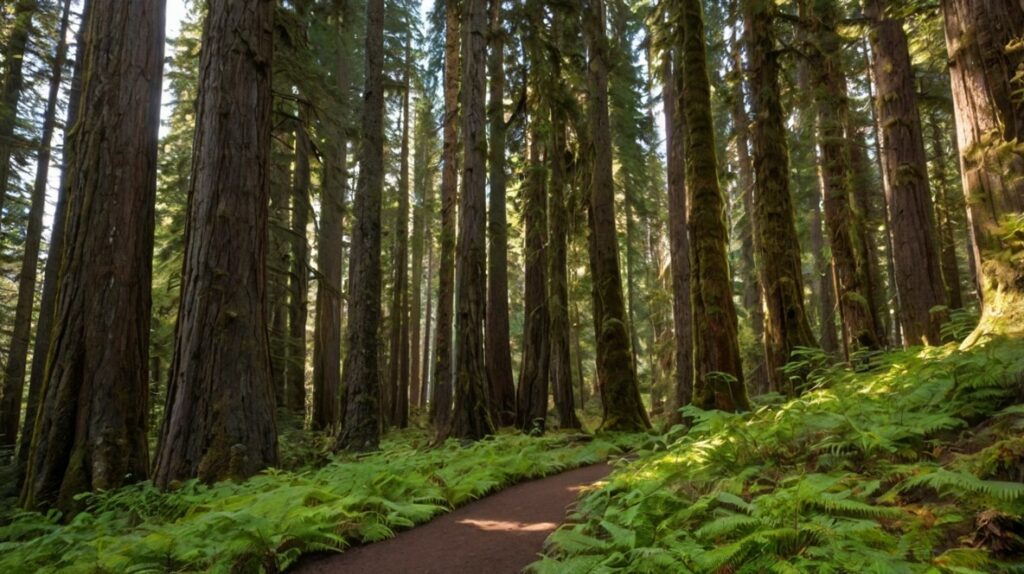
A. Hiking in the Olympic Mountains
On the third day, we’re going to level up our adventure! We’ll be exploring the Olympic Mountains, the highest peaks in Olympic National Park.
1. Popular hiking trails
There are several hiking trails you can choose from, depending on your skill level and the time you have:
- Mount Ellinor: This trail is pretty steep, but the view is champion! From the peak, you can see all the way to Puget Sound and Seattle.
- Hurricane Hill: This is a lighter option. It’s only 3 miles round trip, but still gives you a 360-degree view that’s awesome.
- High Divide Loop: For the pros, this trek can take 2-3 days. But along the way, you’ll be treated to views of mountains, alpine lakes, and maybe even encounter bears or deer.
2. Safety tips for hiking
Hiking in the Olympic Mountains is exciting, but you still need to be careful. Here are some tips for you:
- Always check the weather forecast before heading out. Mountain weather can change very quickly.
- Bring enough gear: water, food, jacket, flashlight, map, and compass.
- Leave no trace. Take all your trash with you.
- Let someone else know your hiking plans.
- Keep a safe distance if you encounter wildlife.
B. Lake Crescent
After we’re done hiking, we’ll cool down at Lake Crescent. This lake is super famous for its crystal clear water and deep blue color.
1. Water activities on the lake
At Lake Crescent, you can do lots of fun activities:
- Kayaking or canoeing: Rent a boat at Lake Crescent Lodge, then explore the lake to your heart’s content.
- Swimming: The water is cold, but super refreshing!
- Fishing: If you’re lucky, you might catch some trout native to this lake.
- Picnicking: Bring some food, then relax by the lake while enjoying the view.
2. Marymere Falls
Not far from Lake Crescent, there’s a beautiful waterfall called Marymere Falls. It’s about 90 feet high, and to get there you have to walk about 1.8 miles round trip.
The trail isn’t too difficult, in fact it’s quite enjoyable. Along the way, you’ll cross wooden bridges over small rivers, then enter a dense and cool forest.
Pro tip: Try photographing the waterfall using the long exposure technique. The result will be super cool, like something out of a travel magazine!
VI. Day Four: Wildlife Wonder
A. Elwha Valley
On the last day, we’ll explore Elwha Valley. This place has a unique story about a super successful ecosystem restoration.
1. Elwha River restoration project
In the past, the Elwha River was dammed for electricity generation. But the dam interfered with salmon migration and messed up the ecosystem. In 2011, the government started a project to remove the dam.
Now, you can see the results:
- Salmon can swim freely again
- Vegetation around the river is recovering
- Wildlife habitat has expanded
Cool, right? This is proof that humans and nature can live in harmony if we make the effort.
2. Wildlife observation
In Elwha Valley, you have a great chance to see wildlife in their natural habitat:
- Roosevelt Elk: The giant deer that’s the icon of Olympic National Park
- Black bears: But remember, keep a safe distance!
- Mountain lions: Rarely seen, but you might get lucky
- Rare birds: Like the Northern Spotted Owl or Marbled Murrelet
Pro tip: Bring binoculars to see animals from afar. Don’t forget to turn off your camera flash so you don’t disturb them.
B. Quinault Rain Forest
To wrap up our journey, we’ll stop by Quinault Rain Forest. This place isn’t as popular as Hoh Rain Forest, but its charm is no less impressive!
1. Trekking through old-growth forest
In Quinault, there are several trails you can choose from:
- Quinault Loop Trail: A short 4-mile trek that gives you an overview of the rainforest
- Graves Creek Trail: For those who want to go deeper into the forest
- Enchanted Valley Trail: A long trek that can take several days, but the view is incredible
Along the way, you’ll be surrounded by old trees that are hundreds of years old. Moss and lichen clinging to the trees make the atmosphere even more mystical.
2. Seeing giant trees
Quinault Rain Forest is famous for its giant trees:
- Quinault Big Cedar: The largest cedar tree in the world
- Quinault Lake Willaby: The largest hemlock tree in the world
- Quinault Big Sitka Spruce: One of the largest Sitka spruce trees
Just imagine, there are trees with diameters bigger than a car! You’ll feel tiny among these green giants.
VII. Accommodation in Olympic National Park
A. Camping inside the park
For adventure lovers, camping in Olympic National Park is an experience not to be missed! There are many campgrounds you can choose from:
- Kalaloch Campground: Located by the beach, perfect for those who love the sound of waves
- Hoh Campground: In the middle of the rainforest, feels like you’re in Jurassic Park!
- Sol Duc Campground: Close to the waterfall and hot springs
- Heart O’ the Hills Campground: Close to Hurricane Ridge, the view is awesome
Remember to make reservations before coming, especially during high season. Don’t forget to bring a waterproof tent, as rain can come suddenly.
B. Nearby lodges and resorts
If you don’t want to bother with camping, there are several lodges and resorts inside the park:
- Lake Crescent Lodge: A beautiful resort by Lake Crescent
- Kalaloch Lodge: Cozy cabins with a view of the Pacific Ocean
- Sol Duc Hot Springs Resort: Has natural hot spring pools!
- Log Cabin Resort: By Lake Crescent, but more budget-friendly
Each place has its own character, so choose according to your taste and budget.
C. Accommodation options in nearby towns
For those who prefer to stay outside the park, there are several nearby towns that could be options:
- Port Angeles: The largest city in the area, with plenty of hotel and restaurant choices
- Forks: Yep, the town that became famous because of Twilight!
- Sequim: A small town known for its lavender fields
- Aberdeen: Kurt Cobain’s hometown, perfect for Nirvana fans
In these towns, you can find various types of accommodation, from cheap motels to cozy B&Bs.
VIII. Local Cuisine and Dining Spots
A. Signature dishes of the Olympic Peninsula
The Olympic Peninsula has unique local cuisine that you must try:
- Fresh salmon: The region’s star fish, can be cooked in various ways
- Dungeness crab: Local crab with a sweet and savory taste
- Blackberry pie: Pie filled with wild berries native to the area
- Razor clam chowder: Creamy soup with delicious razor clams
- Marionberry cobbler: Dessert with local berries similar to blackberries
Don’t forget to try local craft beer or wine from vineyards around Sequim!
B. Recommended restaurants and cafes
Here are some recommended places to eat:
- Next Door Gastro Pub (Port Angeles): Burgers and local craft beer
- Kokopelli Grill (Port Angeles): Fresh seafood with a harbor view
- Creekside Restaurant (Lake Crescent Lodge): Fine dining with local ingredients
- Hard Rain Cafe (Quinault): Tasty sandwiches in the middle of the rainforest
- Granny’s Cafe (Forks): American-style breakfast that’ll keep you full all day
Pro tip: Try stopping by a local farmers market to taste fresh products directly from the farmers!
IX. Tips and Tricks for a Memorable Trip
A. Nature exploration ethics
It’s super important to preserve Olympic National Park. Remember the “Leave No Trace” principle:
- Plan and prepare: Do your research before heading out
- Travel and camp on durable surfaces: Don’t trample vegetation
- Dispose of waste properly: Bring your own trash bag
- Leave what you find: Don’t take anything from the park
- Minimize campfire impacts: Follow rules about campfires
- Respect wildlife: Keep your distance, don’t feed them
- Be considerate of other visitors: Keep quiet, be polite
B. Photography in Olympic National Park
Olympic National Park is a paradise for photographers! Here are some tips:
- Golden hour: Early morning and late afternoon are the best times for photos
- Wide-angle lens: To capture the beauty of the landscape
- Tripod: A must for long exposure shots at waterfalls or night photography
- ND filter: To create a silky effect on waterfalls
- Weather-resistant camera: Because the weather can change suddenly
Remember, always prioritize your safety and the environment over getting a photo!
C. Additional activities to enjoy
Besides what we’ve mentioned, there are many more fun activities in Olympic National Park:
- Cycling: There are several exciting bike trails
- Horseback riding: You can rent horses to explore the park
- Whale watching: In certain seasons, you can see whales from the coast
- Snowshoeing: This is a popular activity during winter
- Stargazing: Due to minimal light pollution, this place is perfect for stargazing
Whatever your interests, there’s sure to be something you can enjoy in Olympic National Park!
X. Conclusion
Well, that’s the exciting journey through Olympic National Park! From mystical rainforests, towering mountains, to beautiful wild beaches, this place truly has it all.
Olympic National Park isn’t just about beautiful scenery, but also about experiences that make us realize how important it is to preserve nature. Here, we can see how nature and humans can coexist harmoniously.
So, when are you planning to go there? Trust me, once you set foot in Olympic National Park, you’ll want to come back again and again. Get ready to fall in love with its natural beauty!
Oh, and don’t forget: “Take nothing but pictures, leave nothing but footprints, kill nothing but time.” Enjoy your adventure in Olympic National Park!
XI. FAQ (5 unique questions)
- Q: What’s this “tree of life” that’s supposedly in Olympic National Park? A: Oh, the “tree of life” is a really unique phenomenon! It’s actually a Sitka spruce tree growing on top of roots that are hanging over a cliff at Kalaloch Beach. The roots are fully exposed due to erosion, but oddly enough, the tree is still alive and thriving. Many people see it as a symbol of nature’s strength and resilience. Pretty cool, right?
- Q: I heard there’s a fairy forest in Olympic National Park? Is that real or just a myth? A: Haha, well, there isn’t an actual fairy forest. But, there’s an area in Hoh Rain Forest called the “Hall of Mosses” because the trees are covered in thick moss. The atmosphere is indeed mystical and magical, like something out of a fairy tale. So, while there aren’t any real fairies, it definitely feels like a fairy-tale world!
- Q: Is it true that there’s a place in Olympic National Park where it’s always raining? A: Yes, that’s actually true! The western part of Olympic National Park, especially around Hoh Rain Forest, is one of the rainiest places in the United States. It gets an average of 140 inches (about 3.5 meters) of rain per year! That’s why the vegetation is so lush. So if you’re going there, a rain jacket is a must-have!
- Q: I heard there’s a haunted lake in Olympic National Park. Is that true? A: Ah, you must be talking about Lake Crescent. There are indeed urban legends saying the lake is haunted due to some mysterious incidents in the past. But don’t worry, Lake Crescent is actually just a regular, incredibly beautiful lake. Its water is super blue because it’s so clear. So don’t be scared, it’s definitely worth a visit!
- Q: Can I camp anywhere I want in Olympic National Park? A: That’s a great question! Actually, you can’t camp just anywhere in Olympic National Park. There are specific areas designated for camping, both in official campgrounds and in the backcountry. If you want to camp in the backcountry, you need to get a permit first. This is to preserve nature and ensure visitors’ safety. So remember, always follow the official park rules!
Well, those are the answers to some unique questions about Olympic National Park. Hope it makes you even more curious and eager to go there soon! Remember, always protect nature and respect the rules so your experience there can be maximized without disturbing the ecosystem. Enjoy your adventure in Olympic National Park!

